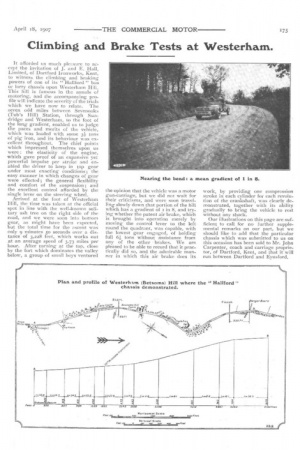Climbing and Brake Tests at Westerham.
Page 45

If you've noticed an error in this article please click here to report it so we can fix it.
It afforded us much pleasure to ac cept the invitation of J. and E. Hall, Limited, of Dartford Ironworks, Kent, to witness the climbing and braking powers of one of its " Hanford " bus or lorry chassis upon Westerham Hilt. This hill is famous in the annals of motoring, and the accompanying profile will indicate the severity of the trials which we have now to relate. The seven odd miles between Sevenoaks (Tub's Hill) Station, through Sundridge and Westerham, to the foot of the long gradient, enabled us to judge frie paces and merits of the vehicle, which was loaded with some 31., tons of pig iron, and its behaviour was excellent throughout. The chief points which impressed themselves upon us were : the elasticity, of the engine, which gave proof of an expansive vet powerful impulse per stroke and enabled the driver to keep in top gear under most exacting conditions ; the easy manner in which changes of gear were effected ; the general flexibility and comfort of the suspension ; and the excellent control afforded by the single lever on the steering wheel.
Arrived at the foot of Westerham Hill, the time was taken at the official spot in line with the well-known solitary ash tree on the right side of the road, and we were soon into bottom gear, as might have been expected, but the total time for the ascent was only 9 minutes 50 seconds over a distance of 3,228 feet, which works out at an average speed of 3.73 miles per hour. After turning at the top, close by the fort which dominates the valley below, a group of small boys ventured the opinion that the vehicle was a motor gun-carriage; but we did not wait for their criticisms, and were soon travelling slowly down that portion of the hill which has a gradient of r in 8, and trying whether the patent air brake, which is brought into operation -merely by moving the control lever to the left round the quadrant, was capable, with the lowest gear engaged, of holding full 61 tons without Assistance from any of the other brakes. We are pleased to be able to record that it practically did so, and the admirable manner in which this air brake does its
work, by providing one compression stroke in each cylinder for each revolution of the crankshaft, was clearly demonstrated, together with its ability gradually to brtng the vehicle to rest without any shock. Our illustrations on this page are sufficient to call for no further supplemental remarks on our part, but we should like to add that the particular chassis which was submitted to us on this occasion has been sold to Mr. John Carpenter, coach and carriage proprietor, of Dartford, Kent, and that it will run between Dartford and Eynsford.






























































